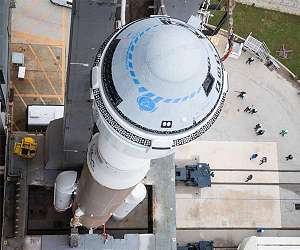New adventures in beds and baths for spaceflight – Space Daily
ESA is expanding its bedrest programme that allows researchers to study how human bodies react to living in space – without leaving their bed.
In weightlessness, astronauts’ bodies lose muscle and bone density, eyes change, fluids shift to the brain and more – our bodies adapted to life on Earth and are not designed for spaceflight.
Finding ways to stay healthy in orbit is a large part of human spaceflight research. The more test subjects the better, but sending people into space is expensive and hard.
Bedrest studies simulate aspects of spaceflight by placing volunteers in bed for long periods of time with their head 6 below horizontal. At all times one shoulder must touch the bed – meals, showers and toilet breaks included.
ESA has conducted many bedrest studies with Medes in Toulouse, France, and at the German aerospace centre DLR’s ‘:envihab’ facility in Cologne, Germany. The space agency is now welcoming the Jozef Stefan Institute based in Planica, Slovenia, to conduct a new round of 60-day studies: one in Toulouse and one in Planica.
The Planica site is a fitting addition, since it is located at high altitude and there is less atmospheric pressure – much like a in future lunar habitat, which adds to simulation. The centre allows researchers to tweak environmental conditions, such as oxygen levels in the room. Testing volunteers in low oxygen levels, or hypoxia, is relevant for future space missions where the confined environment of spacecraft and space habitats could contain less oxygen.
Each site in France, Germany and Slovenia has a centrifuge that can spin volunteers to recreate gravity pulling towards their feet while laying down. Artificial gravity could counteract some of the changes in the human body during space exploration.
“The goal is to definitively test measures that reduce the unwanted effects of living in weightlessness,” explains ESA’s science coordinator for human research Angelique Van Ombergen, “we have a long history at ESA of conducting bedrest studies and this round will put all our knowledge gained towards fine-tuning and working out the best techniques.”
Special exercise machines will be mounted on the centrifuges. The effect of centrifuge spinning alone will be compared to spinning and exercise, and to control groups, to prepare for exploration to the Moon and beyond.
Researchers can submit proposals for experiments they would perform with the brave bedrest volunteers for the studies that will start in the next two years.
Water bed for dry immersion
In a first for ESA, another type of terrestrial study with Medes will use dry-immersion baths. Similar to bath tubs, containers will hold a total of 20 female study participants in suspension for five days each.
Dry-immersion studies benefit from placing less pressure on the body as volunteers are supported and suspended evenly in the tub, a condition that mimics the floating astronauts experience on the International Space Station.
“We decided to start our first dry-immersion protocol with all-women volunteers as there is almost no data on females,” says ESA’s human spaceflight team leader Jennifer Ngo-Anh, “we will not be doing any specific experiments for this first round, but we will collect data to better understand the dry immersion model and how the women react to assess these studies for more extensive investigations in the future.”
Researchers can also apply to access data from the dry-immersion studies on our announcement of opportunities page.
“We get many requests to be a volunteer for these studies,” concludes Jennifer, “but they are no joke, lying in bed sounds fun but the pleasure wears off very quickly – especially when blood is drawn and muscle biopsies are involved – we constantly salute the volunteers that sacrifice their daily lives for the benefit of human exploration!”
The organisations running the studies make their own announcements for bedrest and dry immersion volunteers. Follow their sites if you are still interested in doing your part for human spaceflight science.
The results from this type of research does not only benefit astronauts but has implications for people on Earth who are bedridden for long periods of time for example.
Related Links
Bedrest studies at ESA
Space Tourism, Space Transport and Space Exploration News
| Thanks for being there; We need your help. The SpaceDaily news network continues to grow but revenues have never been harder to maintain. With the rise of Ad Blockers, and Facebook – our traditional revenue sources via quality network advertising continues to decline. And unlike so many other news sites, we don’t have a paywall – with those annoying usernames and passwords. Our news coverage takes time and effort to publish 365 days a year. If you find our news sites informative and useful then please consider becoming a regular supporter or for now make a one off contribution. |
||
| SpaceDaily Monthly Supporter $5+ Billed Monthly |
SpaceDaily Contributor $5 Billed Once credit card or paypal |
|

![]()
Multiple software errors doomed Boeing crew capsule test
Washington (AFP) Feb 8, 2020
Multiple software issues and a poor radio link doomed a test flight of Boeing’s crew capsule late last year, NASA said Friday, revealing for the first time a glitch that could have destroyed the spaceship on its re-entry. The Starliner’s December 20 mission, an uncrewed test flight, was ended early when it failed to engage its thrusters on time, due to a previously reported faulty timer. NASA said in a statement Friday that the problem arose because it incorrectly pulled time from its Atlas V l … read more





